Unwinding / Unwound Exhibition Spotlight
October 20, 2023
“The impetus driving the work in this exhibition does not arise from the need to abolish cohesive traditions. Instead, each work possesses an energetic momentum to protract all-too-familiar art forms by translating, rearticulating, unwinding and rewinding the components of material practices. Yet subtle disloyalties to traditional assumptions regarding craft, tradition, language, meaning, and interpretation murmur. But destabilization is not evident, nor is it the goal of the artists represented in the exhibition… The binary oppositions between functionality and non-functionality, skill and concept, technique and expression, reproducibility and uniqueness, tradition and innovation are simply conceptual hindrances to the twelve artists who ‘unwind,’ not as an act of critique, but as an act of discovery.” –Michelle Grabner, curator of Unwinding / Unwound.

Erica Dincalci, Soft Boundaries, 2023. Hand-dyed silk gauze with embodied form of knitting, 108 x 216 inches. Photo by the artist.
With this statement, Chicago superstar Michelle Grabner reveals the driving force behind the work in her latest curated show: the unwinding of assumptions regarding traditional ‘craft’ as acts of discovery within the textile canon. With a dispassionate stratagem towards textile’s conventions, the work included in Unwinding / Unwound encompasses a broad range of aesthetic concerns and conceptual engagements produced in the foreground of craft’s perennial and critical unwinding.
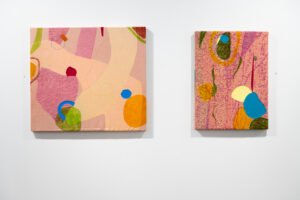
Monica Mohnot, Whimsy Series #6 & 7, 2023. Hand-woven cotton on jacquard loom
25.75 x 24 (left) 24 x 32 (right) inches. Photo: Pilkevich Studios.
Presented by Chicago’s Research House of Asian Art, the show features the work of twelve fiber artists engaged in material innovation and thoughtful making: Krista Anara Cibis, Erica Dincalci, Delaina Doshi, Monica Mohnot, Rivers (Qinnan Zhu), Anne Skaug & Katie BH Wolff, Sitong Yin 尹思桐, Mariana Noreña G, Gigi Gastevich, Iona Bodem and Elizabeth Joo.
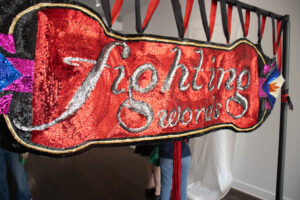
Krista Arana Cibis, Fighting Words, 2023. Hand sequined and beaded, suspended canvas banner, 7 x 8 feet x 18 inches. Photo: Anne Skaug.
At first glance, Delaina Doshi’s Untitled does not appear to be a textile. Hundreds of broken porcelain shards are wired together and embellished with cascading lengths of gold chains. Grabner calls Doshi’s assemblage “an intentional complication to the set of cultural values assigned to cheap collectibles and decorative functional ware.” The same could be said of the piece’s relationship to craft. “My practice is rooted in fiber concepts,” Doshi explains in her artist statement. In this work, “I use piecing and hand stitching to combine shards of crockery into an alternative textile—a tesserae quilt.” Doshi’s deliberate use of pattern, color, and piecing calls upon traditional quilting techniques, yet the piece’s gravity and sharp edges insist it is no ordinary quilt.
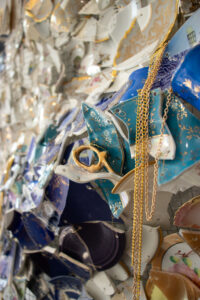
Delaina Doshi, Untitled (detail), 2023. Tessare quilt with broken porcelain, wire and gold chain, 32 x 72 inches. Photo: Anne Skaug .
Like Doshi’s work, I lay on the Earth to Remember the Touch of Your Skin by Anne Skaug & Katie BH Wolff does evoke ‘textile.’ An installation taking up substantial floor space, it is composed of dried prairie grass cast into twelve concrete blocks, punctuated with two freestanding frames that act as “portals to other temporalities.” In this piece, one of craft’s favorite materials—grass—is reworked. Using vegetation harvested from the Great Plains of South Dakota, Skaug and Wolff highlight topographies of grief, the incarnation of internal landscapes, and a longing to hold with tenderness the tension of one’s inheritance.
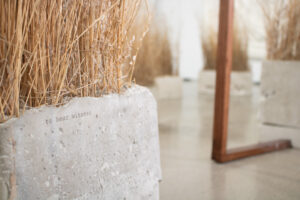
Anne Skaug & Katie BH Wolff, I Lay on the Earth to Remember the Touch of your Skin, 2023. Prairie grass, concrete, plaster, ink, approximately 8 x 16 x 7 feet. Photo by the artists.
Divergence is also present in Gigi Gastevich’s Estate Sale Clocks. The handmade paper is a loose grid of pigmented pulp, alluding to pixels. Upon reading the work’s description, the viewer comes to know that the grid is derived from a Facebook estate-sale image of clocks. Gastevich describes this work as “an exercise in letting go—as careful as I am to keep the lines even and straight, the drippy ooze of paper pulp and limited precision of my hand create an image somewhere between rigid and soft, examining the relationship between the computer-generated and human-crafted.”

Gigi Gastevich, Estate Sale Clocks, 2023. Handmade paper with abaca and pigmented cotton pulp, Facebook marketplace estate sale photograph, 30 x 40 inches. Photo: Anne Skaug.
Gastevich’s approach of digital collaboration correlates to the work of Monica Mohnot, Sitong Yin, Iona Bodem, Erica Dincalci. Their works utilize the TC2 Digital Jacquard loom, and of Elizabeth Joo who used a digital embroidery machine to stitch a log of her emotions over the course of a month.
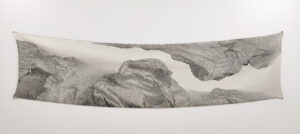
Sitong Yin 尹思桐, Long Scroll #2, 2023. Hand-woven cotton on jacquard loom, 26.5 x 140 inches. Photo by the artist.
In juxtaposition to the technological references in the works described above, pieces by Mariana Norena G, Krista Cibis and Rivers Zhu show the flipside of fiber art: slow handwork. These artists employ laborious hand-stitching of embroidery floss, clay beads, sequins, and lace in each of their works respectively.
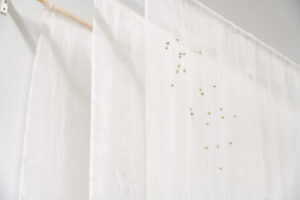
Mariana Noreña G, Untitled (Lake Michigan), 2023. Hand embroidered silk textile with ceramic and indigo dyed beads with paper and cotton thread, 46 x 56 inches. Photo: Eugene Tang.
These different approaches to making do not compete with one another in the show, but instead provide complimentary perspectives amidst craft’s critical unwinding. The work in Unwinding / Unwound seeks to expand on the historical foundations of textiles while fostering new sets of narratives that are responsive to cultures’ ongoing shifts. As Grabner elucidated, “the binary oppositions between functionality and non-functionality, skill and concept, technique and expression, reproducibility and uniqueness, tradition and innovation are simply conceptual hindrances to the twelve artists who ‘unwind,’ not as an act of critique, but as an act of discovery.”
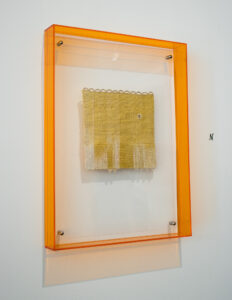
Rivers (Qinnan Zhu), edges*negative spaces, 2023.
Hand dyed threads woven on floor loom with cut-work lacemaking, 14.23 x 13.78 inches. Photo: Anne Skaug.
–Anne Skaug & Delaina Doshi
- Anne Skaug annesart.online | @anne_skaug
- Katie BH Wolff katiebhwolff.com | @katiebhwolff
- Mariana Norena G @mariana.norena.g
- Elizabeth Joo elizabethjoo.art | @e.ay3on
- Monica Mohnot monicamohnot.com | @monica.mohnot
- Delania Doshi delainadoshi.com | @delaina_doshi
